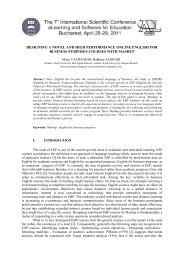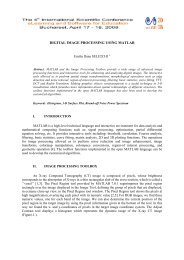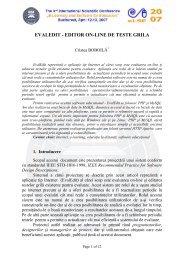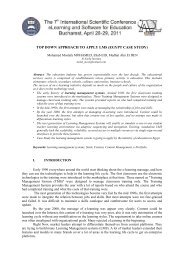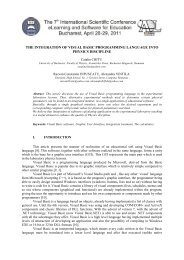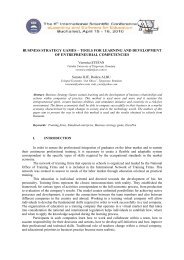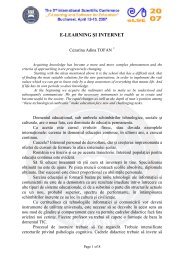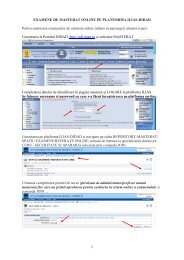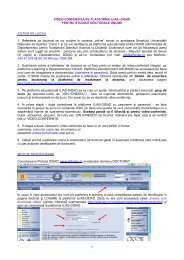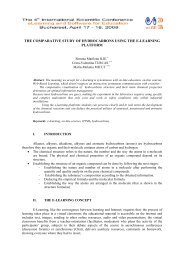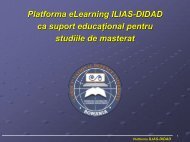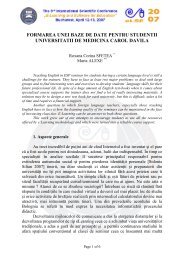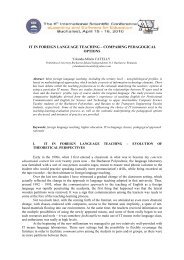Competencies development and enhancement in ELTEC
Competencies development and enhancement in ELTEC
Competencies development and enhancement in ELTEC
Create successful ePaper yourself
Turn your PDF publications into a flip-book with our unique Google optimized e-Paper software.
Distance learn<strong>in</strong>g programs partly address these needs. However, they are<br />
mostly designed as pre-def<strong>in</strong>ed sequences of tra<strong>in</strong><strong>in</strong>g modules, not able to adapt<br />
to <strong>in</strong>dividual knowledge, skills or professional experience of a learner. Whereas<br />
beg<strong>in</strong>ners may benefit from such programs, those that have specific needs due to<br />
change of professional duties or appearance of new products or services they<br />
need to master, require a new type of environment for professional growth<br />
support.<br />
This paper describes an approach to learn<strong>in</strong>g content <strong>development</strong> based<br />
on the professional competency model.<br />
Four-facets competency model<br />
One reason for the <strong>in</strong>creas<strong>in</strong>g importance of competency concept <strong>in</strong><br />
learn<strong>in</strong>g <strong>and</strong> tra<strong>in</strong><strong>in</strong>g is rapid technological <strong>development</strong> <strong>in</strong> society. An<br />
additional reason is that today’s organizations are do<strong>in</strong>g more knowledge <strong>and</strong><br />
service work [6].<br />
We consider competency as a core concept that determ<strong>in</strong>es tra<strong>in</strong><strong>in</strong>g needs.<br />
The follow<strong>in</strong>g basic def<strong>in</strong>ition is used.<br />
Competency - a specific, identifiable, def<strong>in</strong>able, <strong>and</strong> measurable<br />
knowledge, skill, ability <strong>and</strong>/or other deployment-related characteristic (e.g.<br />
attitude, behavior, physical ability) which a human resource may possess <strong>and</strong><br />
which is necessary for, or material to, the performance of an activity with<strong>in</strong> a<br />
specific bus<strong>in</strong>ess context [2].<br />
We suggest the follow<strong>in</strong>g four-facet competency model for efficient<br />
control of competency growth:<br />
1. Structure facet. This facet def<strong>in</strong>es competency structure, its relations to<br />
other competencies <strong>and</strong> thus location with<strong>in</strong> the competency map. We identify<br />
elementary (further non-divisible) competencies <strong>and</strong> complex competencies<br />
which may be described via other (more simple) competencies.<br />
2. Mastery facet. This facet reflects a set of possible mastery levels for a<br />
certa<strong>in</strong> set of competencies, such as beg<strong>in</strong>ner, advanced, professional etc. Thus<br />
it is possible to model quantitative <strong>and</strong> qualitative growth of proficiency <strong>in</strong> some<br />
field <strong>in</strong> case that competency models for beg<strong>in</strong>ner <strong>and</strong> expert are different.<br />
3. KAS facet. Competency may belong to various doma<strong>in</strong>s (categories)<br />
cognitive, affective, <strong>and</strong> psychomotor [1]. Cognitive competency is related to<br />
the mental skills (Knowledge), affective describes growth <strong>in</strong> feel<strong>in</strong>gs or<br />
emotional areas (Attitude), while psychomotor is for manual or physical skills<br />
(Skills). Accord<strong>in</strong>g to KAS (Knowledge, Attitude, Skills) model, after<br />
competency tra<strong>in</strong><strong>in</strong>g (learn<strong>in</strong>g) the learner possesses new skills, knowledge, or<br />
attitudes.<br />
Page 2 of 8



